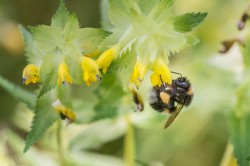Press Release, 01. September 2020
Awareness raising alone is not enough
Nature conservation policy too rarely succeeds in changing people's behaviour
It is a well-known problem: too rarely do nature conservation initiatives, recommendations or strategies announced by politicians lead to people really changing their everyday behaviour. A German-Israeli research team led by the Helmholtz Centre for Environmental Research (UFZ) and the German Centre for Integrative Biodiversity Research (iDiv) has investigated the reasons for this. According to the team, the measures proposed by politicians do not sufficiently exploit the range of possible behavioural interventions and too rarely specify the actual target groups, they write in the journal Conservation Biology.

Photo: André Künzelmann/UFZ

Photo: karegg/AdobeStock
The protection of pollinating insects is a major issue in international nature conservation policy. Stirred up by scientific findings on high population losses of insect groups such as bees or butterflies, which, for example, affect pollination services in agriculture, Europe is putting insect protection at the forefront of environmental policy. Many governments in Europe have presented national strategies to ensure that pollinators are maintained. A team of researchers from UFZ, iDiv and Technion - Israel Institute of Technology analysed the available eight national strategy papers to protect pollinators in terms of behavioural change interventions. The result: "Nature conservation policies to preserve pollinators are often too ineffective in this respect and change little in people's behaviour," says first author and environmental psychologist Dr. Melissa Marselle, who is conducting research at the UFZ and iDiv on the impact of biodiversity on human health.
The scientists coded around 610 behavioural measures in the strategy papers. Using the "Behaviour Change Wheel" theory, which originates from health psychology and integrates 19 different behavioural models, the scientists categorized the behavioural measures for pollinator conservation into the nine different types of interventions - i.e. measures that could change people's behaviour. According to this, most of the 790 or so behavioral measures for pollinator conservation (23 percent) can be assigned to the behaviour change interventions of education and awareness raising, followed by structural measures such as planting hedges, sowing flower strips in fields or creating green spaces in the city (19 percent). Only around four percent of the behavioural measures for pollinator conservation can be summarized under the intervention of modeling, for example, peer-to-peer learning or the use of best-practice examples from farmers who work in exemplary fashion. Other little-mentioned behavioural interventions for pollinator conservation were incentive systems for farmers or municipalities (three percent) and statutory regulations (two percent). Interventions that create a financial cost to discourage a certain behaviour, such as additional taxes on the use of pesticides, did not appear in any of the policy papers for pollinator conservation.
"This shows that national biodiversity strategies focus primarily on educational and structural measures and neglect other effective instruments," says Melissa Marselle. "Educational measures to impart knowledge and to create understanding are important. But relying on education alone is not very effective if you really want to change environmental behaviour. It would be more effective to link it to a wider range of other measures." For example, clearly identifying supply chains and producer principles on labels can encourage many people to buy an organic or pollinator-friendly products - even at a higher price. Stronger financial incentives for farmers who operate sustainably would also be effective, and the certification of sustainable buildings could be linked to the use of pollinator-friendly plants as flower beds. Taxes and additional costs for consumers also ensure rapid changes in behaviour: In the UK, for example, a compulsory levy on the purchase of plastic bags has led to a decline in their use.
A further shortcoming of the strategy papers was identified as the fact that in 41 percent of the behavioural measures for pollinator conservation the target groups whose behaviour needs to change were not named and specified. The objectives are often very well described, but mostly revolve around the question of how certain actions change the environment. However, it is often not defined in more detail to whom the actions are directed and who should implement them: the public, farmers or local authorities? It could be more effective to first consider what the different actors can do, with the help of behavioural researchers, and then, building on that, to consider measures to achieve certain goals.
There are currently several important opportunities to write nature conservation strategies better. For example, the EU Biodiversity Strategy 2030, which the EU Commission adopted in May 2020, needs to be translated into national policies. In addition, at the next conference of the Convention of Biological Diversity (CBD) next year in China, global biodiversity targets for the following years will be negotiated. "Against this background, it is crucial to understand how policies need to be formulated in order to achieve effective implementation of international nature conservation policies", says Prof. Aletta Bonn, who heads the Department of Ecosystem Services at UFZ and iDiv with a research focus on interaction of people and nature.
Publication:
Melissa R. Marselle, Anne Turbe, Assaf Shwartz, Aletta Bonn, Agathe Colléony: "Addressing behavior in pollinator conservation policies to combat the implementation gap", Conservation Biology https://doi.org/10.1111/cobi.13581
Further information
Dr. Melissa Marselle
UFZ Department of Ecosystem Services at UFZ and iDiv
melissa.marselle@ufz.de
Prof. Dr Aletta Bonn
Head of UFZ Department of Ecosystem Services at UFZ and iDiv
aletta.bonn@ufz.de
UFZ press office
Susanne Hufe
Phone: +49 341 6025-1630
presse@ufz.de
In the Helmholtz Centre for Environmental Research (UFZ), scientists conduct research into the causes and consequences of far-reaching environmental changes. Their areas of study cover water resources, ecosystems of the future, environmental technologies and biotechnologies, the effects of chemicals in the environment, modelling and social-scientific issues. The UFZ employs more than 1,100 staff at its sites in Leipzig, Halle and Magdeburg. It is funded by the Federal Government, Saxony and Saxony-Anhalt.
www.ufz.deThe Helmholtz Association contributes to solving major challenges facing society, science and the economy with top scientific achievements in six research fields: Energy; Earth and Environment; Health; Key Technologies; Matter; and Aeronautics, Space and Transport. With some 39,000 employees in 19 research centres, the Helmholtz Association is Germany’s largest scientific organisation.
www.helmholtz.de